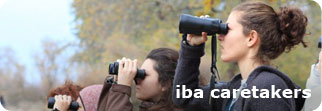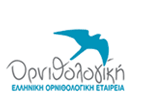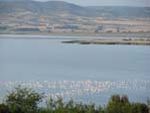|
GR032 Lakes Volvi-Langada (or Koronia-Ag. Vasiliou) and Rentina Gorge (or Makedonika Tempi)
 |
 |
Criteria: A1, A4i, A4iii, B1i, B2, C1, C2, C3, C4, C6
Coordinates:
40o 41' N
23o 22' E
()
|
Altitude: 0-700 m
Area: 43000 ha
|
|
 |
 |
Images
Site Description
The site comprises two freshwater lakes and a gorge. Lake Koronia is shallow, eutrophic and polluted. Lake Volvi is deeper and overflows through the Rentina gorge. The gorge is dominated by maquis and riverine scrub.
 |
 |
Habitats: Artificial landscapes (47%, Arable land), Shrubland (20%, Sclerophyllous scrub, garrigue and maquis), Wetland (27%, Standing freshwater)
Land use: agriculture (55%), fisheries/aquaculture (27%)
|
 |
 |
Protection status
National Partial International Partial
2,100 ha of IBA covered by Wildlife Refuge (Limni Lagada, 2,100 ha). 500 ha of IBA covered by Wildlife Refuge (Paralimnio Dasos Apollonias, 500 ha). 669 ha of IBA covered by Wildlife Refuge (Richios Potamos, 669 ha). 16,388 ha of IBA covered by Ramsar Site (Lakes Volvi and Langada (Koronia), 16,388 ha).
15671 ha of the IBA are covered by Special Protection Area (SPA) LIMNES VOLVI KAI LANGADA KAI STENA RENTINAS(GR1220009).
Birds
This site is important for passage and wintering waterbirds. Species of global conservation concern that do not meet IBA criteria: Aythya nyroca (minimum 43 wintering individuals), Oxyura leucocephala (wintering), Haliaeetus albicilla (wintering), Falco naumanni (passage). The site holds 20,000 or more waterbirds, on a regular basis (including Podiceps cristatus 6,729; Aythya ferina 8,029; Aythya fuligula 1,361; Fulica atra 12,736).
| Species | Season | Year | Min | Max | Acc | Criteria |
|---|
| Aythya ferina Common Pochard | winter | 1997 | 8029 | 8029 | good | B1i, C3
|
| Himantopus himantopus Black-winged Stilt | passage | 1995 | - | 600 | average | B1i, C2
|
| Recurvirostra avosetta Pied Avocet | passage | 1995 | - | 1150 | average | A4i, B1i, C2
|
| Accipiter brevipes Levant Sparrowhawk | breeding | 1992 | Uncommon | poor | B2
|
| Podiceps cristatus Great Crested Grebe | winter | 1997 | 6729 | 6729 | good | B1i, C3
|
| Phalacrocorax pygmeus Pygmy Cormorant | winter | 1997 | 43 | 43 | good | A1, C1
|
| Casmerodius albus Great Egret | winter | 1997 | 35 | 35 | good | A4i, B1i, C2
|
| Phoenicopterus ruber Greater Flamingo | non-breeding | 1995 | - | 1410 | good | A4i, B1i, C2
|
| Pelecanus crispus Dalmatian Pelican | passage | 1995 | - | 473 | good | A1, A4i, B1i, C1, C2
|
| Pelecanus crispus Dalmatian Pelican | winter | 1995 | 249 | 249 | good | A1, A4i, B1i, C1, C2
|
| Ciconia ciconia White Stork | breeding | 1993 | 80 | 100 | good | B2, C6
|
|
Conservation issues
Declining water-levels and water pollution, from agricultural and industrial sources, are a severe threat. A pollution incident in 1995 left thousands of waterbirds dead. In the gorge, fire is a serious problem and has previously caused severe damage. Part of the area is a candidate SAC.
 |
 |
Threats:
agricultural intensification/expansion (high), burning of vegetation (high), forest grazing (medium), groundwater abstraction (high), industrialization/urbanization (high), infrastructure (medium), natural events (medium)
|
 |
 |
Source:
Copyright © Hellenic Ornithological Society
|
|

Do you know the area?
Send us your comments at iba@ornithologiki.gr
If you have noticed serious damage to the area and you want to report it please click here
 
|





